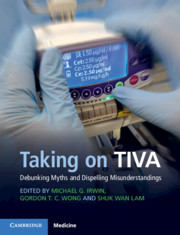Book contents
- Taking on TIVA
- Taking on TIVA
- Copyright page
- Contents
- Contributors
- Foreword
- Power to the People: the Rationale of a Practical Text
- Chapter 1 Why Bother?
- Chapter 2 You Say ‘PK’ and I Say ‘No Way!’; You Say ‘Keo’ and I Say ‘Time to Go!’
- Chapter 3 TCI and TIVA: What a Good Idea!
- Chapter 4 Milk of Amnesia
- Chapter 5 A Catwalk with a Difference
- Chapter 6 Let’s Get Started
- Chapter 7 Let’s Get Pumped!
- Chapter 8 ‘But I’m Used to MAC!’
- Chapter 9 Be Aware, Unaware and Confusion Everywhere
- Chapter 10 Do You Want Fries with That?
- Chapter 11 Intra- and Post-operative Analgesia for TIVA
- Chapter 12 Wakey Wakey!
- Chapter 13 Under Pressure
- Chapter 14 Ankle Biters
- Chapter 15 Old Timers
- Chapter 16 Big Can Be Beautiful!
- Chapter 17 A Bun in the Oven
- Chapter 18 Saving the Whales by Taking on TIVA
- Chapter 19 TIVA Drugs for Sedation
- Chapter 20 Skiing Off-Piste and Other Assorted Goodies
- Index
- References
Chapter 9 - Be Aware, Unaware and Confusion Everywhere
TIVA and Awareness
Published online by Cambridge University Press: 18 November 2019
- Taking on TIVA
- Taking on TIVA
- Copyright page
- Contents
- Contributors
- Foreword
- Power to the People: the Rationale of a Practical Text
- Chapter 1 Why Bother?
- Chapter 2 You Say ‘PK’ and I Say ‘No Way!’; You Say ‘Keo’ and I Say ‘Time to Go!’
- Chapter 3 TCI and TIVA: What a Good Idea!
- Chapter 4 Milk of Amnesia
- Chapter 5 A Catwalk with a Difference
- Chapter 6 Let’s Get Started
- Chapter 7 Let’s Get Pumped!
- Chapter 8 ‘But I’m Used to MAC!’
- Chapter 9 Be Aware, Unaware and Confusion Everywhere
- Chapter 10 Do You Want Fries with That?
- Chapter 11 Intra- and Post-operative Analgesia for TIVA
- Chapter 12 Wakey Wakey!
- Chapter 13 Under Pressure
- Chapter 14 Ankle Biters
- Chapter 15 Old Timers
- Chapter 16 Big Can Be Beautiful!
- Chapter 17 A Bun in the Oven
- Chapter 18 Saving the Whales by Taking on TIVA
- Chapter 19 TIVA Drugs for Sedation
- Chapter 20 Skiing Off-Piste and Other Assorted Goodies
- Index
- References
Summary
All anaesthetists need to be skilled in the administration of IV anaesthesia, yet evidence from the 5th National Audit Project (NAP5) of the Royal College of Anaesthetists and the Association of Anaesthetists of Great Britain and Ireland documenting cases of accidental awareness during general anaesthesia (AAGA) suggests that this might not be the case. TIVA is used in only 7% of cases, with preponderance for certain surgical operations such as those on the airway where administration of an inhaled anaesthetic is not feasible. Conversely, TIVA has been almost completely avoided in other types of surgery such as Caesarean sections, at least in the UK and Ireland. TIVA is also used for transfer of patients and in remote areas that do not have the equipment required to deliver inhaled anaesthesia. For the purpose of this discussion, it should be clarified from the outset that there are several modes of TIVA delivery. The majority is target-controlled infusion (TCI), carried out with dedicated PK pumps and used in ~5% of all cases or ~81% of TIVA cases. The most basic is manual boluses of propofol using a hand-held syringe: the anaesthetist simply injects the amount they judge necessary to maintain anaesthesia (0.7% of all UK cases, or ~10% of all TIVA cases). The third is non-TCI infusions, which constitute ~0.6% of all cases, or ~9% of TIVA cases. However, there is some international geographic variation in this practice, because in the United States TCI remains unlicensed and therefore seldom used.
- Type
- Chapter
- Information
- Taking on TIVADebunking Myths and Dispelling Misunderstandings, pp. 63 - 72Publisher: Cambridge University PressPrint publication year: 2019



